Geology and Soil Mechanics: Classification, Properties, and Uses
VerifiedAdded on 2020/01/28
|17
|4096
|56
Homework Assignment
AI Summary
This document provides a detailed analysis of geology and soil mechanics, covering various aspects such as the geographical, physical, and chemical classification of rocks. It delves into the uses of rocks in construction, the classification of aggregates, and specific tasks related to Bowen's reaction series, rock mass, and geological discontinuities. The assignment also explores soil description, soil classification, and key soil properties like void ratio, degree of saturation, and cohesion. Furthermore, it encompasses the characteristics of rocks, including texture, structure, and grain size, and differentiates between fine-grained soils. The document offers insights into the practical applications of these concepts within civil engineering and construction.

Geology and Soil Mechanics
Paraphrase This Document
Need a fresh take? Get an instant paraphrase of this document with our AI Paraphraser
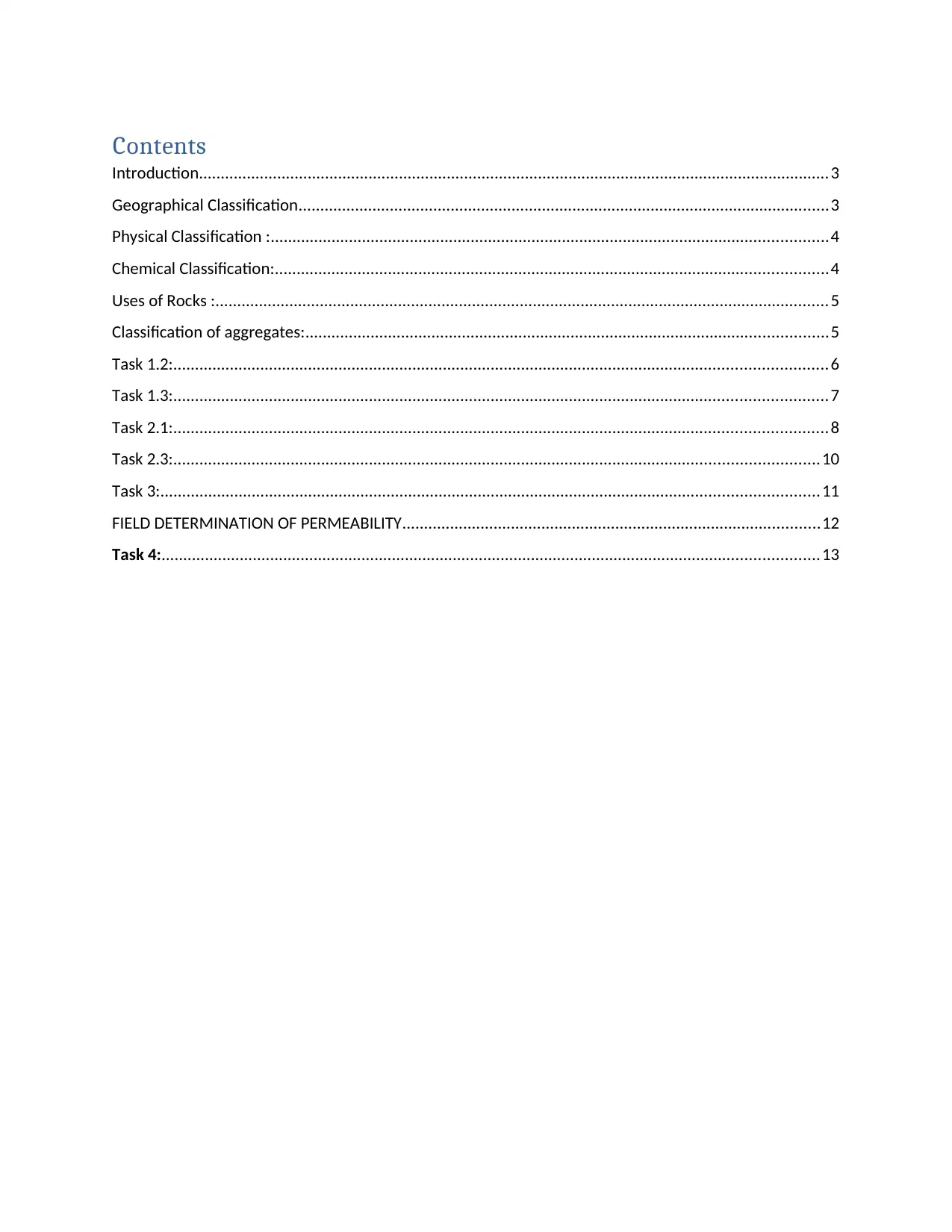
Contents
Introduction.................................................................................................................................................3
Geographical Classification..........................................................................................................................3
Physical Classification :................................................................................................................................4
Chemical Classification:...............................................................................................................................4
Uses of Rocks :.............................................................................................................................................5
Classification of aggregates:........................................................................................................................5
Task 1.2:......................................................................................................................................................6
Task 1.3:......................................................................................................................................................7
Task 2.1:......................................................................................................................................................8
Task 2.3:....................................................................................................................................................10
Task 3:.......................................................................................................................................................11
FIELD DETERMINATION OF PERMEABILITY................................................................................................12
Task 4:.......................................................................................................................................................13
Introduction.................................................................................................................................................3
Geographical Classification..........................................................................................................................3
Physical Classification :................................................................................................................................4
Chemical Classification:...............................................................................................................................4
Uses of Rocks :.............................................................................................................................................5
Classification of aggregates:........................................................................................................................5
Task 1.2:......................................................................................................................................................6
Task 1.3:......................................................................................................................................................7
Task 2.1:......................................................................................................................................................8
Task 2.3:....................................................................................................................................................10
Task 3:.......................................................................................................................................................11
FIELD DETERMINATION OF PERMEABILITY................................................................................................12
Task 4:.......................................................................................................................................................13
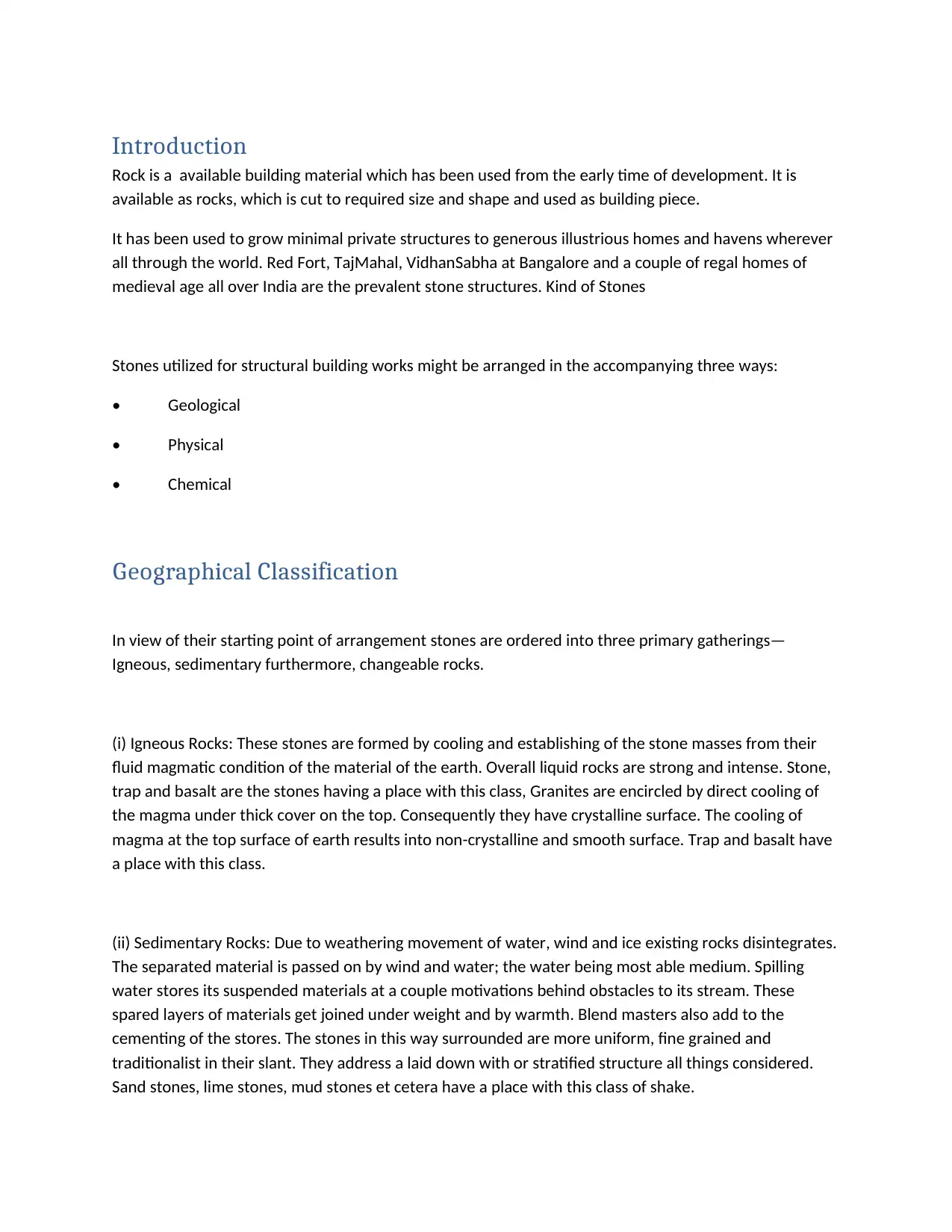
Introduction
Rock is a available building material which has been used from the early time of development. It is
available as rocks, which is cut to required size and shape and used as building piece.
It has been used to grow minimal private structures to generous illustrious homes and havens wherever
all through the world. Red Fort, TajMahal, VidhanSabha at Bangalore and a couple of regal homes of
medieval age all over India are the prevalent stone structures. Kind of Stones
Stones utilized for structural building works might be arranged in the accompanying three ways:
• Geological
• Physical
• Chemical
Geographical Classification
In view of their starting point of arrangement stones are ordered into three primary gatherings—
Igneous, sedimentary furthermore, changeable rocks.
(i) Igneous Rocks: These stones are formed by cooling and establishing of the stone masses from their
fluid magmatic condition of the material of the earth. Overall liquid rocks are strong and intense. Stone,
trap and basalt are the stones having a place with this class, Granites are encircled by direct cooling of
the magma under thick cover on the top. Consequently they have crystalline surface. The cooling of
magma at the top surface of earth results into non-crystalline and smooth surface. Trap and basalt have
a place with this class.
(ii) Sedimentary Rocks: Due to weathering movement of water, wind and ice existing rocks disintegrates.
The separated material is passed on by wind and water; the water being most able medium. Spilling
water stores its suspended materials at a couple motivations behind obstacles to its stream. These
spared layers of materials get joined under weight and by warmth. Blend masters also add to the
cementing of the stores. The stones in this way surrounded are more uniform, fine grained and
traditionalist in their slant. They address a laid down with or stratified structure all things considered.
Sand stones, lime stones, mud stones et cetera have a place with this class of shake.
Rock is a available building material which has been used from the early time of development. It is
available as rocks, which is cut to required size and shape and used as building piece.
It has been used to grow minimal private structures to generous illustrious homes and havens wherever
all through the world. Red Fort, TajMahal, VidhanSabha at Bangalore and a couple of regal homes of
medieval age all over India are the prevalent stone structures. Kind of Stones
Stones utilized for structural building works might be arranged in the accompanying three ways:
• Geological
• Physical
• Chemical
Geographical Classification
In view of their starting point of arrangement stones are ordered into three primary gatherings—
Igneous, sedimentary furthermore, changeable rocks.
(i) Igneous Rocks: These stones are formed by cooling and establishing of the stone masses from their
fluid magmatic condition of the material of the earth. Overall liquid rocks are strong and intense. Stone,
trap and basalt are the stones having a place with this class, Granites are encircled by direct cooling of
the magma under thick cover on the top. Consequently they have crystalline surface. The cooling of
magma at the top surface of earth results into non-crystalline and smooth surface. Trap and basalt have
a place with this class.
(ii) Sedimentary Rocks: Due to weathering movement of water, wind and ice existing rocks disintegrates.
The separated material is passed on by wind and water; the water being most able medium. Spilling
water stores its suspended materials at a couple motivations behind obstacles to its stream. These
spared layers of materials get joined under weight and by warmth. Blend masters also add to the
cementing of the stores. The stones in this way surrounded are more uniform, fine grained and
traditionalist in their slant. They address a laid down with or stratified structure all things considered.
Sand stones, lime stones, mud stones et cetera have a place with this class of shake.
⊘ This is a preview!⊘
Do you want full access?
Subscribe today to unlock all pages.

Trusted by 1+ million students worldwide
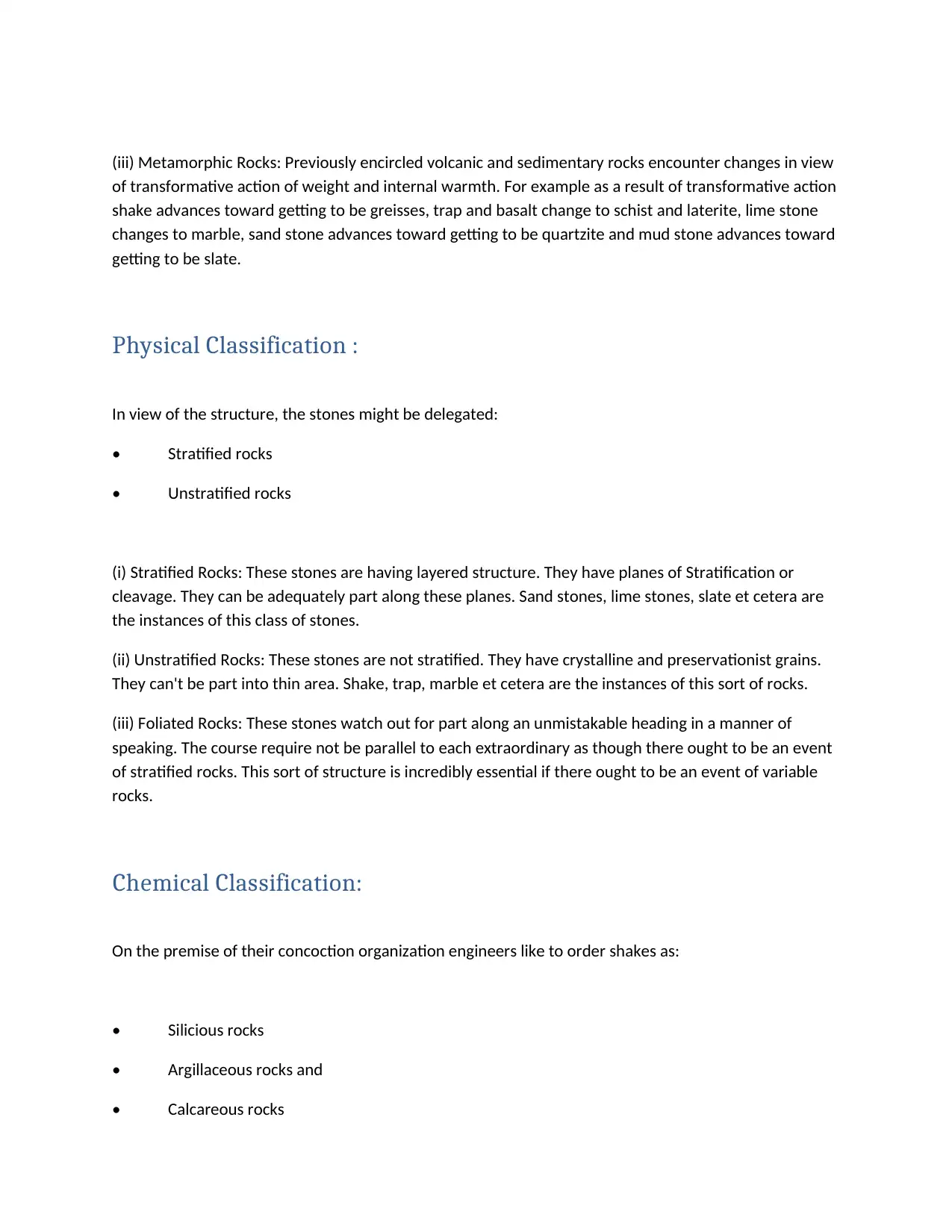
(iii) Metamorphic Rocks: Previously encircled volcanic and sedimentary rocks encounter changes in view
of transformative action of weight and internal warmth. For example as a result of transformative action
shake advances toward getting to be greisses, trap and basalt change to schist and laterite, lime stone
changes to marble, sand stone advances toward getting to be quartzite and mud stone advances toward
getting to be slate.
Physical Classification :
In view of the structure, the stones might be delegated:
• Stratified rocks
• Unstratified rocks
(i) Stratified Rocks: These stones are having layered structure. They have planes of Stratification or
cleavage. They can be adequately part along these planes. Sand stones, lime stones, slate et cetera are
the instances of this class of stones.
(ii) Unstratified Rocks: These stones are not stratified. They have crystalline and preservationist grains.
They can't be part into thin area. Shake, trap, marble et cetera are the instances of this sort of rocks.
(iii) Foliated Rocks: These stones watch out for part along an unmistakable heading in a manner of
speaking. The course require not be parallel to each extraordinary as though there ought to be an event
of stratified rocks. This sort of structure is incredibly essential if there ought to be an event of variable
rocks.
Chemical Classification:
On the premise of their concoction organization engineers like to order shakes as:
• Silicious rocks
• Argillaceous rocks and
• Calcareous rocks
of transformative action of weight and internal warmth. For example as a result of transformative action
shake advances toward getting to be greisses, trap and basalt change to schist and laterite, lime stone
changes to marble, sand stone advances toward getting to be quartzite and mud stone advances toward
getting to be slate.
Physical Classification :
In view of the structure, the stones might be delegated:
• Stratified rocks
• Unstratified rocks
(i) Stratified Rocks: These stones are having layered structure. They have planes of Stratification or
cleavage. They can be adequately part along these planes. Sand stones, lime stones, slate et cetera are
the instances of this class of stones.
(ii) Unstratified Rocks: These stones are not stratified. They have crystalline and preservationist grains.
They can't be part into thin area. Shake, trap, marble et cetera are the instances of this sort of rocks.
(iii) Foliated Rocks: These stones watch out for part along an unmistakable heading in a manner of
speaking. The course require not be parallel to each extraordinary as though there ought to be an event
of stratified rocks. This sort of structure is incredibly essential if there ought to be an event of variable
rocks.
Chemical Classification:
On the premise of their concoction organization engineers like to order shakes as:
• Silicious rocks
• Argillaceous rocks and
• Calcareous rocks
Paraphrase This Document
Need a fresh take? Get an instant paraphrase of this document with our AI Paraphraser
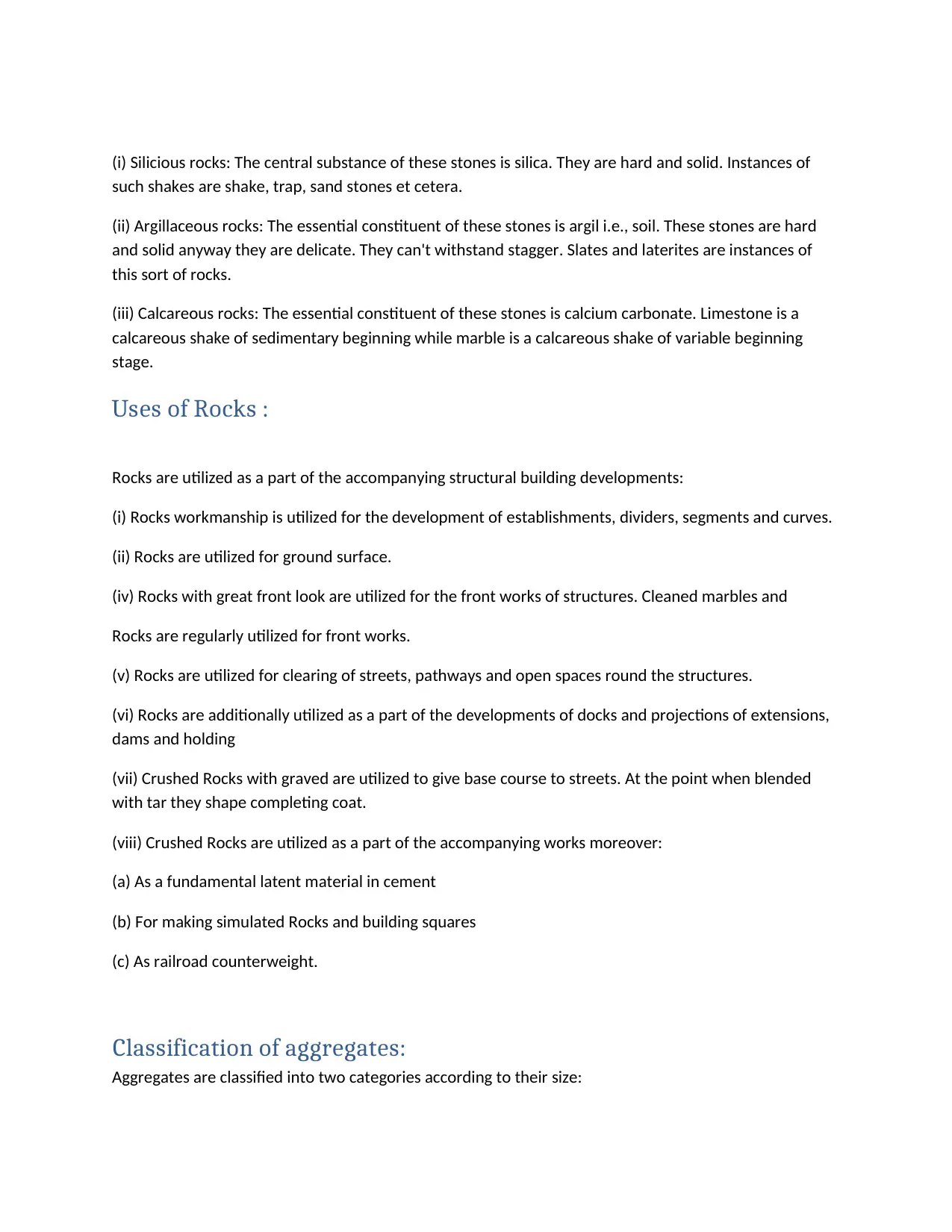
(i) Silicious rocks: The central substance of these stones is silica. They are hard and solid. Instances of
such shakes are shake, trap, sand stones et cetera.
(ii) Argillaceous rocks: The essential constituent of these stones is argil i.e., soil. These stones are hard
and solid anyway they are delicate. They can't withstand stagger. Slates and laterites are instances of
this sort of rocks.
(iii) Calcareous rocks: The essential constituent of these stones is calcium carbonate. Limestone is a
calcareous shake of sedimentary beginning while marble is a calcareous shake of variable beginning
stage.
Uses of Rocks :
Rocks are utilized as a part of the accompanying structural building developments:
(i) Rocks workmanship is utilized for the development of establishments, dividers, segments and curves.
(ii) Rocks are utilized for ground surface.
(iv) Rocks with great front look are utilized for the front works of structures. Cleaned marbles and
Rocks are regularly utilized for front works.
(v) Rocks are utilized for clearing of streets, pathways and open spaces round the structures.
(vi) Rocks are additionally utilized as a part of the developments of docks and projections of extensions,
dams and holding
(vii) Crushed Rocks with graved are utilized to give base course to streets. At the point when blended
with tar they shape completing coat.
(viii) Crushed Rocks are utilized as a part of the accompanying works moreover:
(a) As a fundamental latent material in cement
(b) For making simulated Rocks and building squares
(c) As railroad counterweight.
Classification of aggregates:
Aggregates are classified into two categories according to their size:
such shakes are shake, trap, sand stones et cetera.
(ii) Argillaceous rocks: The essential constituent of these stones is argil i.e., soil. These stones are hard
and solid anyway they are delicate. They can't withstand stagger. Slates and laterites are instances of
this sort of rocks.
(iii) Calcareous rocks: The essential constituent of these stones is calcium carbonate. Limestone is a
calcareous shake of sedimentary beginning while marble is a calcareous shake of variable beginning
stage.
Uses of Rocks :
Rocks are utilized as a part of the accompanying structural building developments:
(i) Rocks workmanship is utilized for the development of establishments, dividers, segments and curves.
(ii) Rocks are utilized for ground surface.
(iv) Rocks with great front look are utilized for the front works of structures. Cleaned marbles and
Rocks are regularly utilized for front works.
(v) Rocks are utilized for clearing of streets, pathways and open spaces round the structures.
(vi) Rocks are additionally utilized as a part of the developments of docks and projections of extensions,
dams and holding
(vii) Crushed Rocks with graved are utilized to give base course to streets. At the point when blended
with tar they shape completing coat.
(viii) Crushed Rocks are utilized as a part of the accompanying works moreover:
(a) As a fundamental latent material in cement
(b) For making simulated Rocks and building squares
(c) As railroad counterweight.
Classification of aggregates:
Aggregates are classified into two categories according to their size:
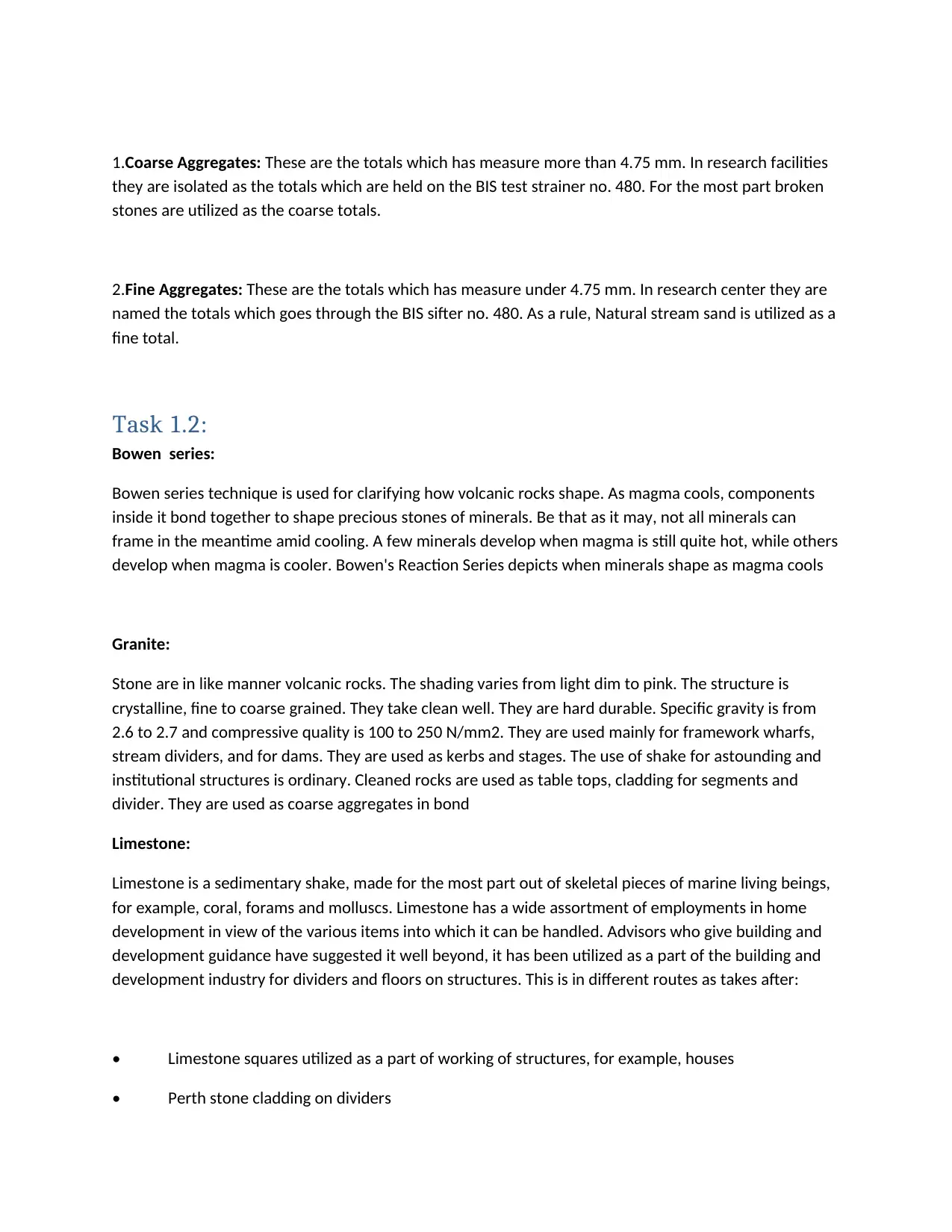
1.Coarse Aggregates: These are the totals which has measure more than 4.75 mm. In research facilities
they are isolated as the totals which are held on the BIS test strainer no. 480. For the most part broken
stones are utilized as the coarse totals.
2.Fine Aggregates: These are the totals which has measure under 4.75 mm. In research center they are
named the totals which goes through the BIS sifter no. 480. As a rule, Natural stream sand is utilized as a
fine total.
Task 1.2:
Bowen series:
Bowen series technique is used for clarifying how volcanic rocks shape. As magma cools, components
inside it bond together to shape precious stones of minerals. Be that as it may, not all minerals can
frame in the meantime amid cooling. A few minerals develop when magma is still quite hot, while others
develop when magma is cooler. Bowen's Reaction Series depicts when minerals shape as magma cools
Granite:
Stone are in like manner volcanic rocks. The shading varies from light dim to pink. The structure is
crystalline, fine to coarse grained. They take clean well. They are hard durable. Specific gravity is from
2.6 to 2.7 and compressive quality is 100 to 250 N/mm2. They are used mainly for framework wharfs,
stream dividers, and for dams. They are used as kerbs and stages. The use of shake for astounding and
institutional structures is ordinary. Cleaned rocks are used as table tops, cladding for segments and
divider. They are used as coarse aggregates in bond
Limestone:
Limestone is a sedimentary shake, made for the most part out of skeletal pieces of marine living beings,
for example, coral, forams and molluscs. Limestone has a wide assortment of employments in home
development in view of the various items into which it can be handled. Advisors who give building and
development guidance have suggested it well beyond, it has been utilized as a part of the building and
development industry for dividers and floors on structures. This is in different routes as takes after:
• Limestone squares utilized as a part of working of structures, for example, houses
• Perth stone cladding on dividers
they are isolated as the totals which are held on the BIS test strainer no. 480. For the most part broken
stones are utilized as the coarse totals.
2.Fine Aggregates: These are the totals which has measure under 4.75 mm. In research center they are
named the totals which goes through the BIS sifter no. 480. As a rule, Natural stream sand is utilized as a
fine total.
Task 1.2:
Bowen series:
Bowen series technique is used for clarifying how volcanic rocks shape. As magma cools, components
inside it bond together to shape precious stones of minerals. Be that as it may, not all minerals can
frame in the meantime amid cooling. A few minerals develop when magma is still quite hot, while others
develop when magma is cooler. Bowen's Reaction Series depicts when minerals shape as magma cools
Granite:
Stone are in like manner volcanic rocks. The shading varies from light dim to pink. The structure is
crystalline, fine to coarse grained. They take clean well. They are hard durable. Specific gravity is from
2.6 to 2.7 and compressive quality is 100 to 250 N/mm2. They are used mainly for framework wharfs,
stream dividers, and for dams. They are used as kerbs and stages. The use of shake for astounding and
institutional structures is ordinary. Cleaned rocks are used as table tops, cladding for segments and
divider. They are used as coarse aggregates in bond
Limestone:
Limestone is a sedimentary shake, made for the most part out of skeletal pieces of marine living beings,
for example, coral, forams and molluscs. Limestone has a wide assortment of employments in home
development in view of the various items into which it can be handled. Advisors who give building and
development guidance have suggested it well beyond, it has been utilized as a part of the building and
development industry for dividers and floors on structures. This is in different routes as takes after:
• Limestone squares utilized as a part of working of structures, for example, houses
• Perth stone cladding on dividers
⊘ This is a preview!⊘
Do you want full access?
Subscribe today to unlock all pages.

Trusted by 1+ million students worldwide
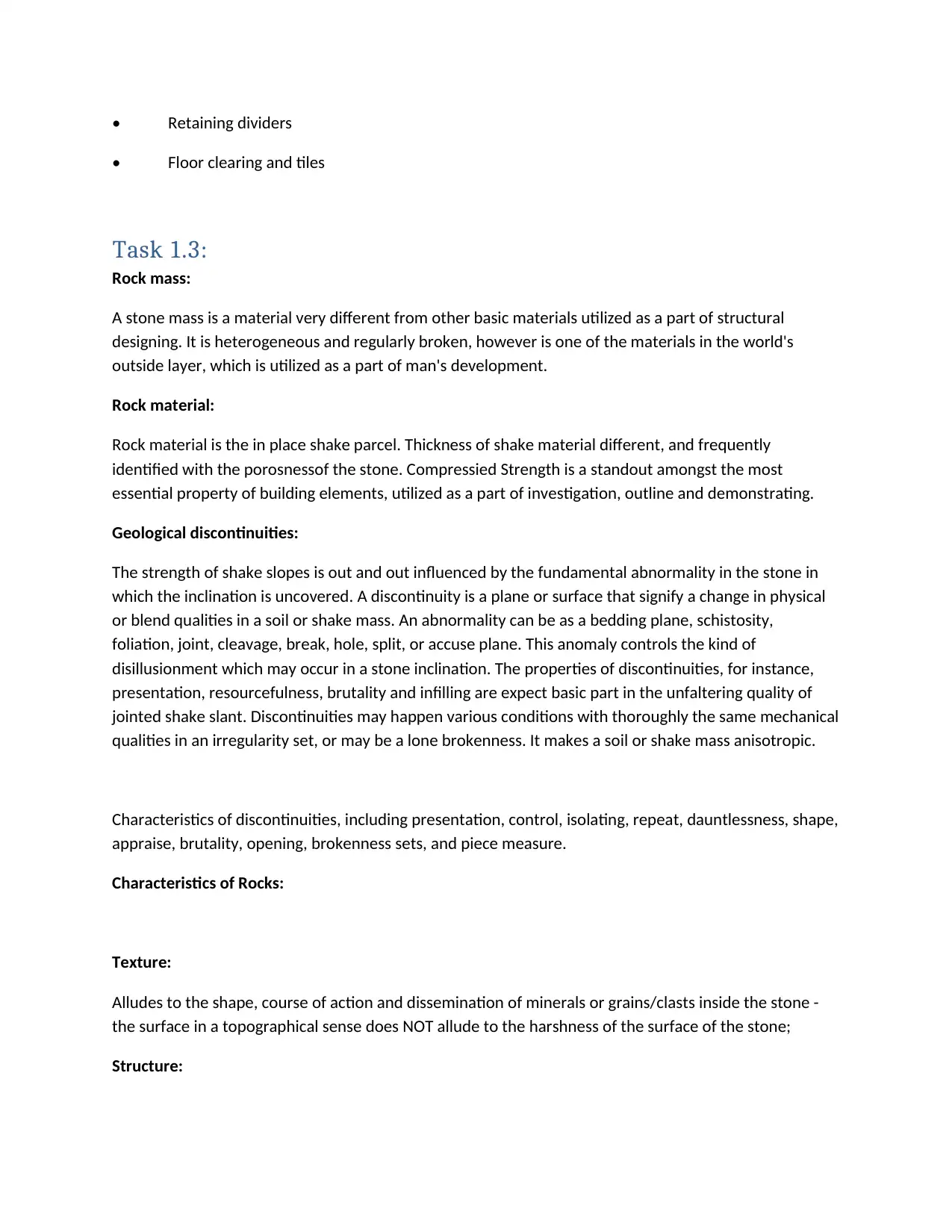
• Retaining dividers
• Floor clearing and tiles
Task 1.3:
Rock mass:
A stone mass is a material very different from other basic materials utilized as a part of structural
designing. It is heterogeneous and regularly broken, however is one of the materials in the world's
outside layer, which is utilized as a part of man's development.
Rock material:
Rock material is the in place shake parcel. Thickness of shake material different, and frequently
identified with the porosnessof the stone. Compressied Strength is a standout amongst the most
essential property of building elements, utilized as a part of investigation, outline and demonstrating.
Geological discontinuities:
The strength of shake slopes is out and out influenced by the fundamental abnormality in the stone in
which the inclination is uncovered. A discontinuity is a plane or surface that signify a change in physical
or blend qualities in a soil or shake mass. An abnormality can be as a bedding plane, schistosity,
foliation, joint, cleavage, break, hole, split, or accuse plane. This anomaly controls the kind of
disillusionment which may occur in a stone inclination. The properties of discontinuities, for instance,
presentation, resourcefulness, brutality and infilling are expect basic part in the unfaltering quality of
jointed shake slant. Discontinuities may happen various conditions with thoroughly the same mechanical
qualities in an irregularity set, or may be a lone brokenness. It makes a soil or shake mass anisotropic.
Characteristics of discontinuities, including presentation, control, isolating, repeat, dauntlessness, shape,
appraise, brutality, opening, brokenness sets, and piece measure.
Characteristics of Rocks:
Texture:
Alludes to the shape, course of action and dissemination of minerals or grains/clasts inside the stone -
the surface in a topographical sense does NOT allude to the harshness of the surface of the stone;
Structure:
• Floor clearing and tiles
Task 1.3:
Rock mass:
A stone mass is a material very different from other basic materials utilized as a part of structural
designing. It is heterogeneous and regularly broken, however is one of the materials in the world's
outside layer, which is utilized as a part of man's development.
Rock material:
Rock material is the in place shake parcel. Thickness of shake material different, and frequently
identified with the porosnessof the stone. Compressied Strength is a standout amongst the most
essential property of building elements, utilized as a part of investigation, outline and demonstrating.
Geological discontinuities:
The strength of shake slopes is out and out influenced by the fundamental abnormality in the stone in
which the inclination is uncovered. A discontinuity is a plane or surface that signify a change in physical
or blend qualities in a soil or shake mass. An abnormality can be as a bedding plane, schistosity,
foliation, joint, cleavage, break, hole, split, or accuse plane. This anomaly controls the kind of
disillusionment which may occur in a stone inclination. The properties of discontinuities, for instance,
presentation, resourcefulness, brutality and infilling are expect basic part in the unfaltering quality of
jointed shake slant. Discontinuities may happen various conditions with thoroughly the same mechanical
qualities in an irregularity set, or may be a lone brokenness. It makes a soil or shake mass anisotropic.
Characteristics of discontinuities, including presentation, control, isolating, repeat, dauntlessness, shape,
appraise, brutality, opening, brokenness sets, and piece measure.
Characteristics of Rocks:
Texture:
Alludes to the shape, course of action and dissemination of minerals or grains/clasts inside the stone -
the surface in a topographical sense does NOT allude to the harshness of the surface of the stone;
Structure:
Paraphrase This Document
Need a fresh take? Get an instant paraphrase of this document with our AI Paraphraser
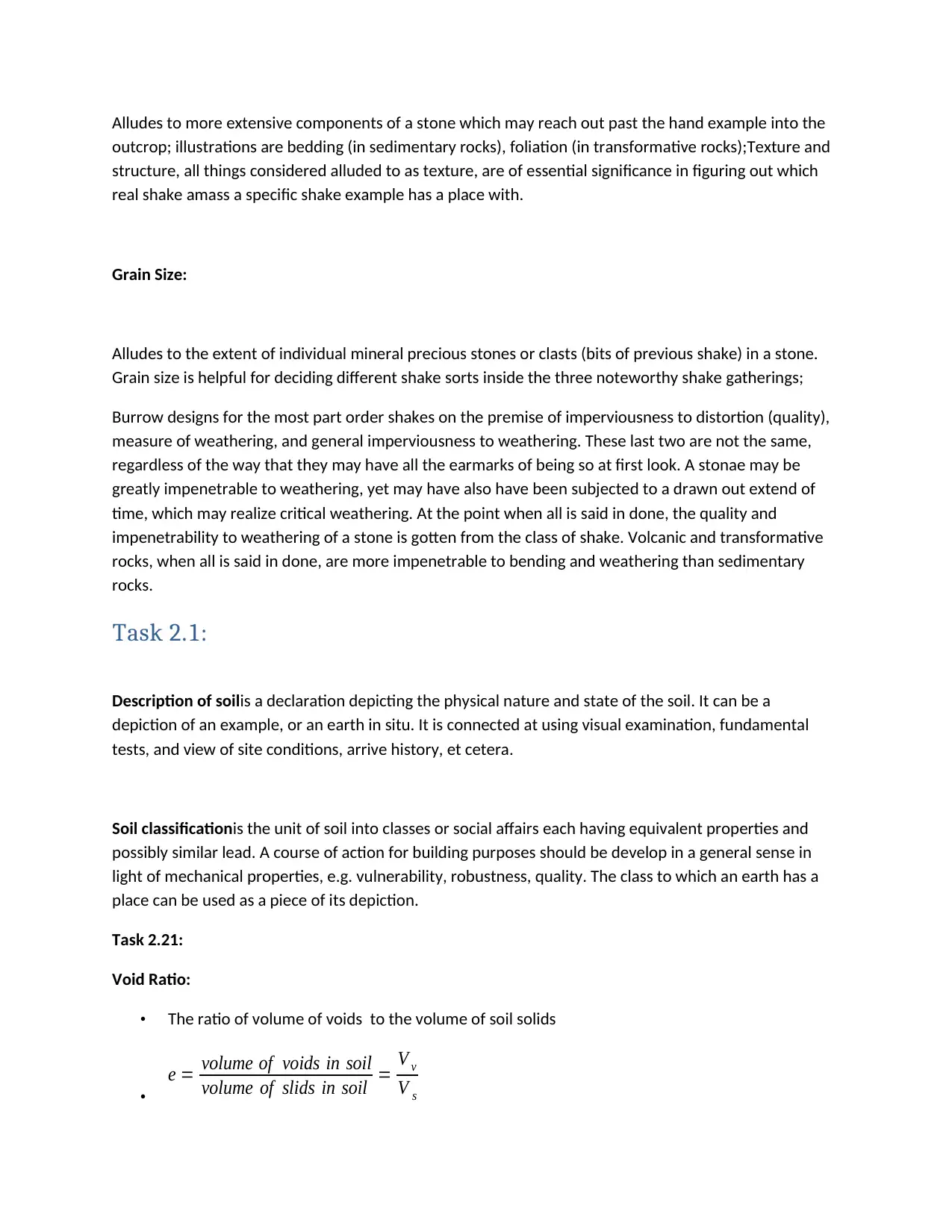
Alludes to more extensive components of a stone which may reach out past the hand example into the
outcrop; illustrations are bedding (in sedimentary rocks), foliation (in transformative rocks);Texture and
structure, all things considered alluded to as texture, are of essential significance in figuring out which
real shake amass a specific shake example has a place with.
Grain Size:
Alludes to the extent of individual mineral precious stones or clasts (bits of previous shake) in a stone.
Grain size is helpful for deciding different shake sorts inside the three noteworthy shake gatherings;
Burrow designs for the most part order shakes on the premise of imperviousness to distortion (quality),
measure of weathering, and general imperviousness to weathering. These last two are not the same,
regardless of the way that they may have all the earmarks of being so at first look. A stonae may be
greatly impenetrable to weathering, yet may have also have been subjected to a drawn out extend of
time, which may realize critical weathering. At the point when all is said in done, the quality and
impenetrability to weathering of a stone is gotten from the class of shake. Volcanic and transformative
rocks, when all is said in done, are more impenetrable to bending and weathering than sedimentary
rocks.
Task 2.1:
Description of soilis a declaration depicting the physical nature and state of the soil. It can be a
depiction of an example, or an earth in situ. It is connected at using visual examination, fundamental
tests, and view of site conditions, arrive history, et cetera.
Soil classificationis the unit of soil into classes or social affairs each having equivalent properties and
possibly similar lead. A course of action for building purposes should be develop in a general sense in
light of mechanical properties, e.g. vulnerability, robustness, quality. The class to which an earth has a
place can be used as a piece of its depiction.
Task 2.21:
Void Ratio:
• The ratio of volume of voids to the volume of soil solids
•
e = volume of voids in soil
volume of slids in soil = V v
V s
outcrop; illustrations are bedding (in sedimentary rocks), foliation (in transformative rocks);Texture and
structure, all things considered alluded to as texture, are of essential significance in figuring out which
real shake amass a specific shake example has a place with.
Grain Size:
Alludes to the extent of individual mineral precious stones or clasts (bits of previous shake) in a stone.
Grain size is helpful for deciding different shake sorts inside the three noteworthy shake gatherings;
Burrow designs for the most part order shakes on the premise of imperviousness to distortion (quality),
measure of weathering, and general imperviousness to weathering. These last two are not the same,
regardless of the way that they may have all the earmarks of being so at first look. A stonae may be
greatly impenetrable to weathering, yet may have also have been subjected to a drawn out extend of
time, which may realize critical weathering. At the point when all is said in done, the quality and
impenetrability to weathering of a stone is gotten from the class of shake. Volcanic and transformative
rocks, when all is said in done, are more impenetrable to bending and weathering than sedimentary
rocks.
Task 2.1:
Description of soilis a declaration depicting the physical nature and state of the soil. It can be a
depiction of an example, or an earth in situ. It is connected at using visual examination, fundamental
tests, and view of site conditions, arrive history, et cetera.
Soil classificationis the unit of soil into classes or social affairs each having equivalent properties and
possibly similar lead. A course of action for building purposes should be develop in a general sense in
light of mechanical properties, e.g. vulnerability, robustness, quality. The class to which an earth has a
place can be used as a piece of its depiction.
Task 2.21:
Void Ratio:
• The ratio of volume of voids to the volume of soil solids
•
e = volume of voids in soil
volume of slids in soil = V v
V s
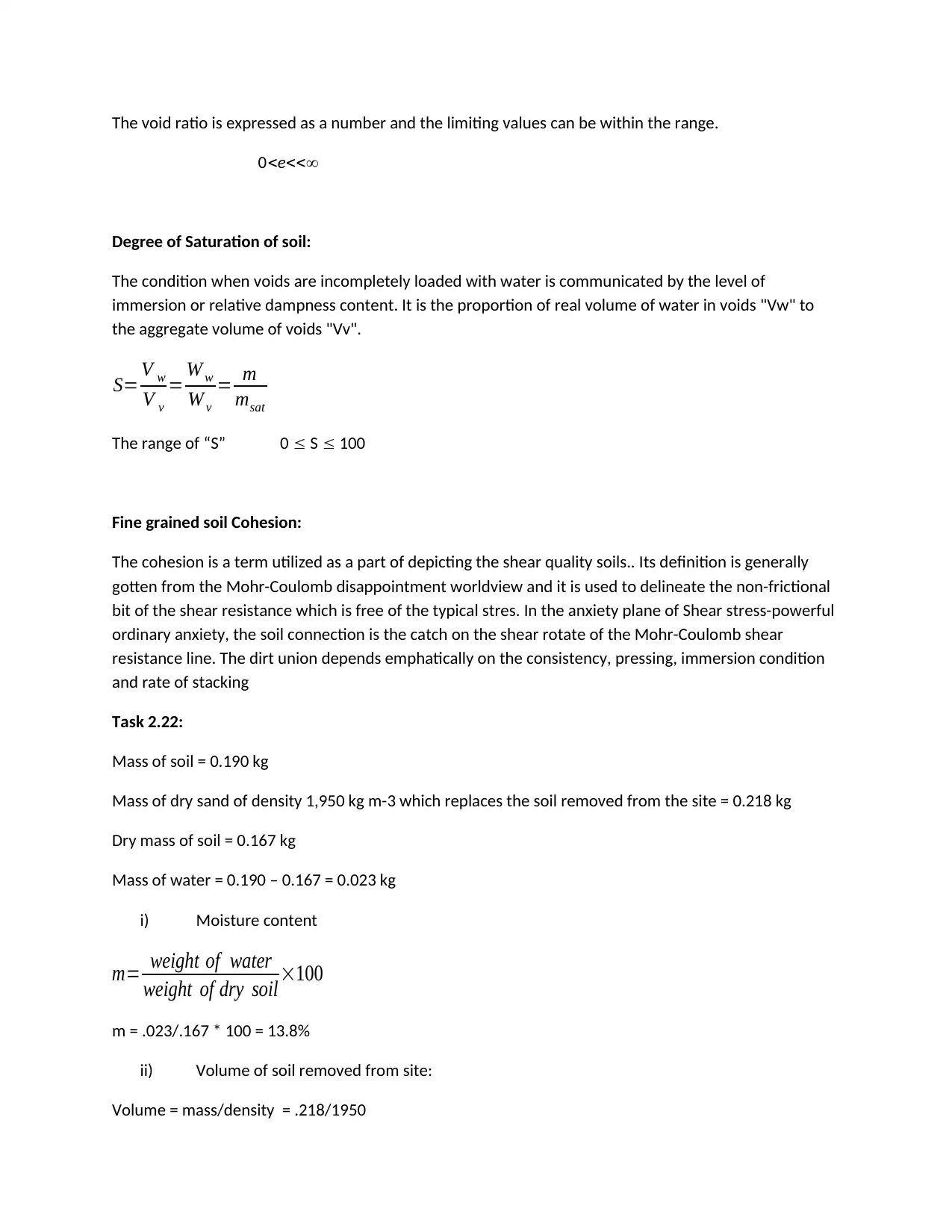
The void ratio is expressed as a number and the limiting values can be within the range.
0<e<<¥
Degree of Saturation of soil:
The condition when voids are incompletely loaded with water is communicated by the level of
immersion or relative dampness content. It is the proportion of real volume of water in voids "Vw" to
the aggregate volume of voids "Vv".
S= V w
V v
= W w
W v
= m
msat
The range of “S” 0 £ S £ 100
Fine grained soil Cohesion:
The cohesion is a term utilized as a part of depicting the shear quality soils.. Its definition is generally
gotten from the Mohr-Coulomb disappointment worldview and it is used to delineate the non-frictional
bit of the shear resistance which is free of the typical stres. In the anxiety plane of Shear stress-powerful
ordinary anxiety, the soil connection is the catch on the shear rotate of the Mohr-Coulomb shear
resistance line. The dirt union depends emphatically on the consistency, pressing, immersion condition
and rate of stacking
Task 2.22:
Mass of soil = 0.190 kg
Mass of dry sand of density 1,950 kg m-3 which replaces the soil removed from the site = 0.218 kg
Dry mass of soil = 0.167 kg
Mass of water = 0.190 – 0.167 = 0.023 kg
i) Moisture content
m= weight of water
weight of dry soil ×100
m = .023/.167 * 100 = 13.8%
ii) Volume of soil removed from site:
Volume = mass/density = .218/1950
0<e<<¥
Degree of Saturation of soil:
The condition when voids are incompletely loaded with water is communicated by the level of
immersion or relative dampness content. It is the proportion of real volume of water in voids "Vw" to
the aggregate volume of voids "Vv".
S= V w
V v
= W w
W v
= m
msat
The range of “S” 0 £ S £ 100
Fine grained soil Cohesion:
The cohesion is a term utilized as a part of depicting the shear quality soils.. Its definition is generally
gotten from the Mohr-Coulomb disappointment worldview and it is used to delineate the non-frictional
bit of the shear resistance which is free of the typical stres. In the anxiety plane of Shear stress-powerful
ordinary anxiety, the soil connection is the catch on the shear rotate of the Mohr-Coulomb shear
resistance line. The dirt union depends emphatically on the consistency, pressing, immersion condition
and rate of stacking
Task 2.22:
Mass of soil = 0.190 kg
Mass of dry sand of density 1,950 kg m-3 which replaces the soil removed from the site = 0.218 kg
Dry mass of soil = 0.167 kg
Mass of water = 0.190 – 0.167 = 0.023 kg
i) Moisture content
m= weight of water
weight of dry soil ×100
m = .023/.167 * 100 = 13.8%
ii) Volume of soil removed from site:
Volume = mass/density = .218/1950
⊘ This is a preview!⊘
Do you want full access?
Subscribe today to unlock all pages.

Trusted by 1+ million students worldwide
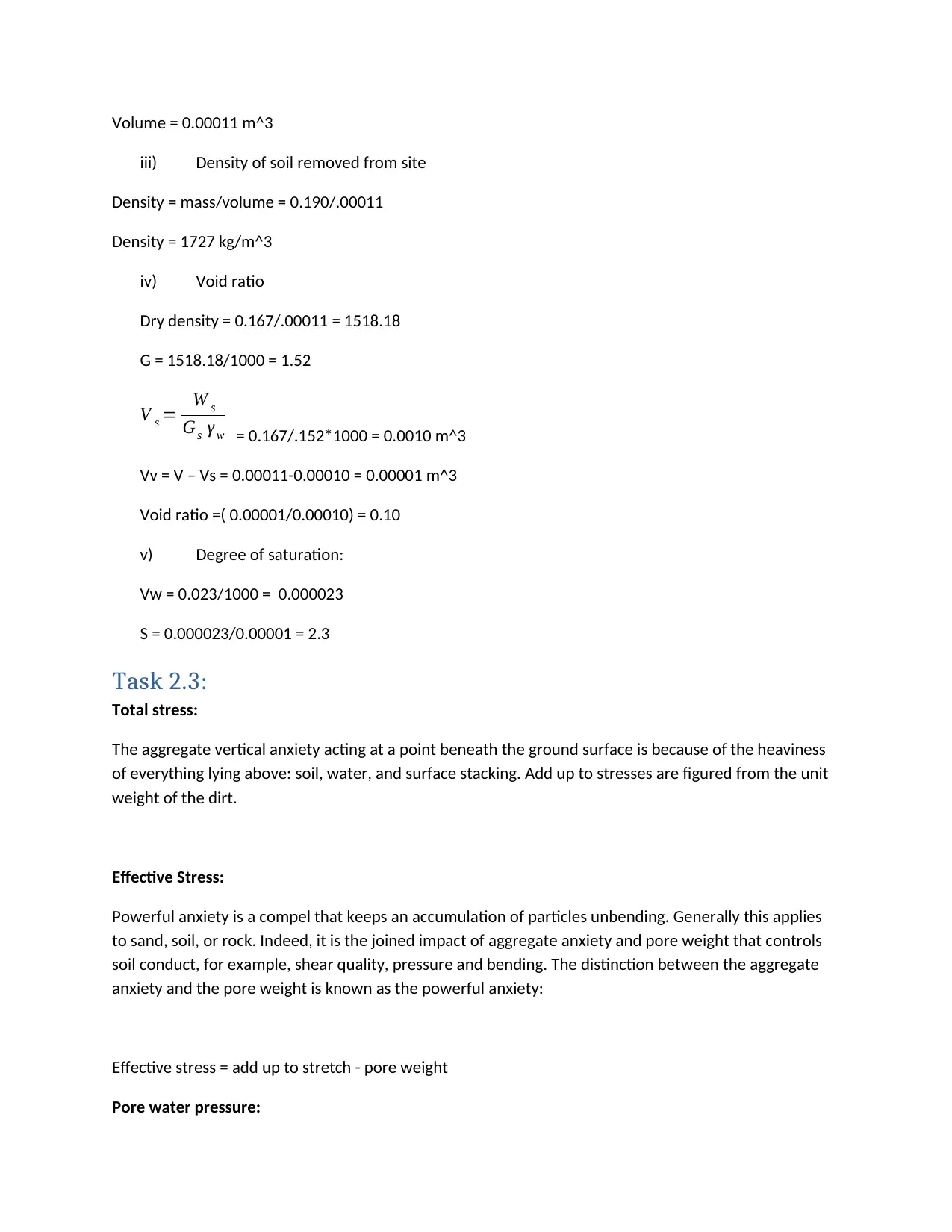
Volume = 0.00011 m^3
iii) Density of soil removed from site
Density = mass/volume = 0.190/.00011
Density = 1727 kg/m^3
iv) Void ratio
Dry density = 0.167/.00011 = 1518.18
G = 1518.18/1000 = 1.52
V s = W s
Gs γ w = 0.167/.152*1000 = 0.0010 m^3
Vv = V – Vs = 0.00011-0.00010 = 0.00001 m^3
Void ratio =( 0.00001/0.00010) = 0.10
v) Degree of saturation:
Vw = 0.023/1000 = 0.000023
S = 0.000023/0.00001 = 2.3
Task 2.3:
Total stress:
The aggregate vertical anxiety acting at a point beneath the ground surface is because of the heaviness
of everything lying above: soil, water, and surface stacking. Add up to stresses are figured from the unit
weight of the dirt.
Effective Stress:
Powerful anxiety is a compel that keeps an accumulation of particles unbending. Generally this applies
to sand, soil, or rock. Indeed, it is the joined impact of aggregate anxiety and pore weight that controls
soil conduct, for example, shear quality, pressure and bending. The distinction between the aggregate
anxiety and the pore weight is known as the powerful anxiety:
Effective stress = add up to stretch - pore weight
Pore water pressure:
iii) Density of soil removed from site
Density = mass/volume = 0.190/.00011
Density = 1727 kg/m^3
iv) Void ratio
Dry density = 0.167/.00011 = 1518.18
G = 1518.18/1000 = 1.52
V s = W s
Gs γ w = 0.167/.152*1000 = 0.0010 m^3
Vv = V – Vs = 0.00011-0.00010 = 0.00001 m^3
Void ratio =( 0.00001/0.00010) = 0.10
v) Degree of saturation:
Vw = 0.023/1000 = 0.000023
S = 0.000023/0.00001 = 2.3
Task 2.3:
Total stress:
The aggregate vertical anxiety acting at a point beneath the ground surface is because of the heaviness
of everything lying above: soil, water, and surface stacking. Add up to stresses are figured from the unit
weight of the dirt.
Effective Stress:
Powerful anxiety is a compel that keeps an accumulation of particles unbending. Generally this applies
to sand, soil, or rock. Indeed, it is the joined impact of aggregate anxiety and pore weight that controls
soil conduct, for example, shear quality, pressure and bending. The distinction between the aggregate
anxiety and the pore weight is known as the powerful anxiety:
Effective stress = add up to stretch - pore weight
Pore water pressure:
Paraphrase This Document
Need a fresh take? Get an instant paraphrase of this document with our AI Paraphraser
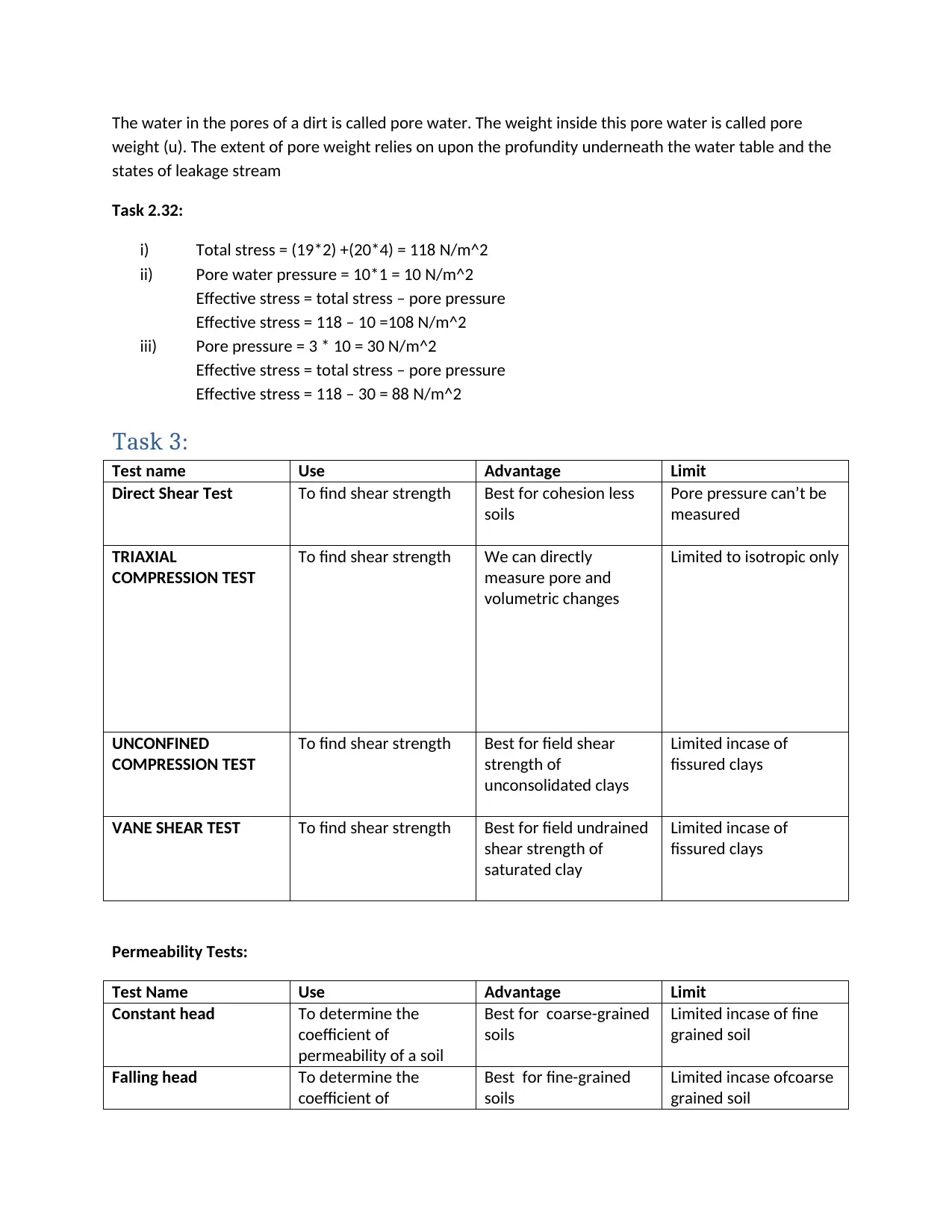
The water in the pores of a dirt is called pore water. The weight inside this pore water is called pore
weight (u). The extent of pore weight relies on upon the profundity underneath the water table and the
states of leakage stream
Task 2.32:
i) Total stress = (19*2) +(20*4) = 118 N/m^2
ii) Pore water pressure = 10*1 = 10 N/m^2
Effective stress = total stress – pore pressure
Effective stress = 118 – 10 =108 N/m^2
iii) Pore pressure = 3 * 10 = 30 N/m^2
Effective stress = total stress – pore pressure
Effective stress = 118 – 30 = 88 N/m^2
Task 3:
Test name Use Advantage Limit
Direct Shear Test To find shear strength Best for cohesion less
soils
Pore pressure can’t be
measured
TRIAXIAL
COMPRESSION TEST
To find shear strength We can directly
measure pore and
volumetric changes
Limited to isotropic only
UNCONFINED
COMPRESSION TEST
To find shear strength Best for field shear
strength of
unconsolidated clays
Limited incase of
fissured clays
VANE SHEAR TEST To find shear strength Best for field undrained
shear strength of
saturated clay
Limited incase of
fissured clays
Permeability Tests:
Test Name Use Advantage Limit
Constant head To determine the
coefficient of
permeability of a soil
Best for coarse-grained
soils
Limited incase of fine
grained soil
Falling head To determine the
coefficient of
Best for fine-grained
soils
Limited incase ofcoarse
grained soil
weight (u). The extent of pore weight relies on upon the profundity underneath the water table and the
states of leakage stream
Task 2.32:
i) Total stress = (19*2) +(20*4) = 118 N/m^2
ii) Pore water pressure = 10*1 = 10 N/m^2
Effective stress = total stress – pore pressure
Effective stress = 118 – 10 =108 N/m^2
iii) Pore pressure = 3 * 10 = 30 N/m^2
Effective stress = total stress – pore pressure
Effective stress = 118 – 30 = 88 N/m^2
Task 3:
Test name Use Advantage Limit
Direct Shear Test To find shear strength Best for cohesion less
soils
Pore pressure can’t be
measured
TRIAXIAL
COMPRESSION TEST
To find shear strength We can directly
measure pore and
volumetric changes
Limited to isotropic only
UNCONFINED
COMPRESSION TEST
To find shear strength Best for field shear
strength of
unconsolidated clays
Limited incase of
fissured clays
VANE SHEAR TEST To find shear strength Best for field undrained
shear strength of
saturated clay
Limited incase of
fissured clays
Permeability Tests:
Test Name Use Advantage Limit
Constant head To determine the
coefficient of
permeability of a soil
Best for coarse-grained
soils
Limited incase of fine
grained soil
Falling head To determine the
coefficient of
Best for fine-grained
soils
Limited incase ofcoarse
grained soil
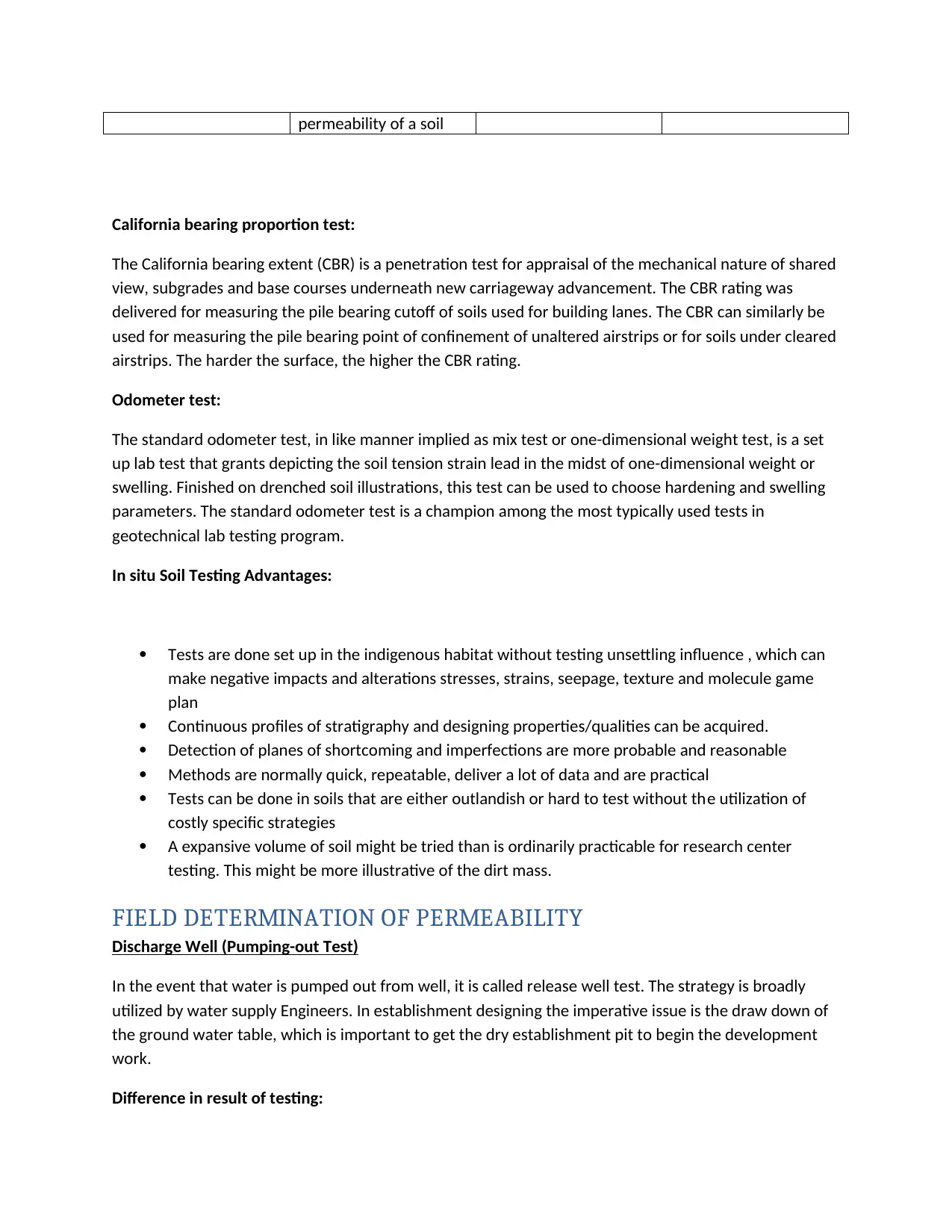
permeability of a soil
California bearing proportion test:
The California bearing extent (CBR) is a penetration test for appraisal of the mechanical nature of shared
view, subgrades and base courses underneath new carriageway advancement. The CBR rating was
delivered for measuring the pile bearing cutoff of soils used for building lanes. The CBR can similarly be
used for measuring the pile bearing point of confinement of unaltered airstrips or for soils under cleared
airstrips. The harder the surface, the higher the CBR rating.
Odometer test:
The standard odometer test, in like manner implied as mix test or one-dimensional weight test, is a set
up lab test that grants depicting the soil tension strain lead in the midst of one-dimensional weight or
swelling. Finished on drenched soil illustrations, this test can be used to choose hardening and swelling
parameters. The standard odometer test is a champion among the most typically used tests in
geotechnical lab testing program.
In situ Soil Testing Advantages:
Tests are done set up in the indigenous habitat without testing unsettling influence , which can
make negative impacts and alterations stresses, strains, seepage, texture and molecule game
plan
Continuous profiles of stratigraphy and designing properties/qualities can be acquired.
Detection of planes of shortcoming and imperfections are more probable and reasonable
Methods are normally quick, repeatable, deliver a lot of data and are practical
Tests can be done in soils that are either outlandish or hard to test without the utilization of
costly specific strategies
A expansive volume of soil might be tried than is ordinarily practicable for research center
testing. This might be more illustrative of the dirt mass.
FIELD DETERMINATION OF PERMEABILITY
Discharge Well (Pumping-out Test)
In the event that water is pumped out from well, it is called release well test. The strategy is broadly
utilized by water supply Engineers. In establishment designing the imperative issue is the draw down of
the ground water table, which is important to get the dry establishment pit to begin the development
work.
Difference in result of testing:
California bearing proportion test:
The California bearing extent (CBR) is a penetration test for appraisal of the mechanical nature of shared
view, subgrades and base courses underneath new carriageway advancement. The CBR rating was
delivered for measuring the pile bearing cutoff of soils used for building lanes. The CBR can similarly be
used for measuring the pile bearing point of confinement of unaltered airstrips or for soils under cleared
airstrips. The harder the surface, the higher the CBR rating.
Odometer test:
The standard odometer test, in like manner implied as mix test or one-dimensional weight test, is a set
up lab test that grants depicting the soil tension strain lead in the midst of one-dimensional weight or
swelling. Finished on drenched soil illustrations, this test can be used to choose hardening and swelling
parameters. The standard odometer test is a champion among the most typically used tests in
geotechnical lab testing program.
In situ Soil Testing Advantages:
Tests are done set up in the indigenous habitat without testing unsettling influence , which can
make negative impacts and alterations stresses, strains, seepage, texture and molecule game
plan
Continuous profiles of stratigraphy and designing properties/qualities can be acquired.
Detection of planes of shortcoming and imperfections are more probable and reasonable
Methods are normally quick, repeatable, deliver a lot of data and are practical
Tests can be done in soils that are either outlandish or hard to test without the utilization of
costly specific strategies
A expansive volume of soil might be tried than is ordinarily practicable for research center
testing. This might be more illustrative of the dirt mass.
FIELD DETERMINATION OF PERMEABILITY
Discharge Well (Pumping-out Test)
In the event that water is pumped out from well, it is called release well test. The strategy is broadly
utilized by water supply Engineers. In establishment designing the imperative issue is the draw down of
the ground water table, which is important to get the dry establishment pit to begin the development
work.
Difference in result of testing:
⊘ This is a preview!⊘
Do you want full access?
Subscribe today to unlock all pages.

Trusted by 1+ million students worldwide
1 out of 17
Your All-in-One AI-Powered Toolkit for Academic Success.
+13062052269
info@desklib.com
Available 24*7 on WhatsApp / Email
![[object Object]](/_next/static/media/star-bottom.7253800d.svg)
Unlock your academic potential
Copyright © 2020–2025 A2Z Services. All Rights Reserved. Developed and managed by ZUCOL.
